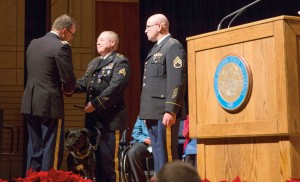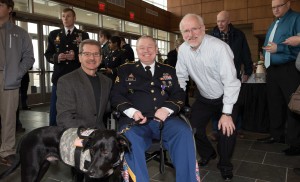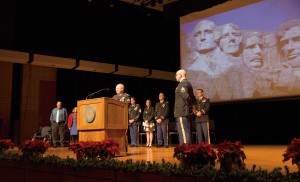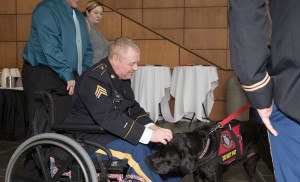Last May, Richard Bogue earned a degree he never thought he would receive. Seven months later, he received an award he wished he would have never received.

Sgt. Richard Bogue, center, shakes hands with Col. Stan Carrigan after receiving his Purple Heart Medal at the ceremony in the Performing Arts Center at South Dakota State University. Bogue, of White, is a May 2014 graduate of SDSU. At right is Staff Sgt. Walter Scott.
Bogue, 46, of White, received a degree in ag biosystems technology at the May 2014 commencement. Certainly not the geological engineering degree he had in mind when he enrolled at South Dakota School of Mines and Technology some 20 years earlier; not even the ag engineering degree he envisioned earning when he enrolled at SDSU in 2009.
But Bogue also never envisioned being on the stage of the SDSU Performing Arts Center Dec. 13, 2014, in full military uniform.
The Stuart, Nebraska, native, who grew up in Rapid City, enlisted in the U.S. Army Reserves in 2008 while still 39. He marked his 40th birthday with basic training exercises at Fort Bragg, North Carolina. After six months of basic and advanced training at Fort Bragg, he returned to White, his home since 2005.

Bogue flashes a big grin while posing with SDSU President David L. Chicoine, left, and Van Kelley, head of the ag engineering department at State. They were among a number of university personnel attending Bogue’s Purple Heart ceremony Dec. 13, 2014.
He went back to his job at Perry Electric and then enrolled at State. But a year later his unit, the 407th Civil Affairs Battalion in Arden Hills, Minnesota, deployed to Afghanistan.
So began a one-year adventure marked with narrow escapes and one disabling hit. That and what one of Bogue’s military superiors called his “warrior spirit†are the reasons he was bearing the personal discomfort of the stage lights at the Performing Arts Center Dec. 13, 2014.
Three and one-half years after being wounded in Kandahar City, Afghanistan, U.S. Army Reserve Sgt. Richard L. Bogue was presented the Purple Heart at an hourlong ceremony, the first Purple Heart ceremony at the university in recent memory.
The traumatic brain injuries he received make it difficult for him to travel the four hours to his battalion’s headquarters in the Twin Cities. So arrangements were made by his unit and Michelle Ruesink, who is with the SDSU Veteran’s Affairs Office, to have the Purple Heart ceremony on campus.
Approximately 250 people were on hand, including representatives of various military organizations, family and university officials.
Bogue was joined onstage by his wife and son as well as some of his former officers and fellow servicemen.
Water ditches and warfare
Honored guest at the ceremony was Chief Master Sgt. Richard Simonsen, who was riding with Bogue in the back of a V-hulled troop carrier as part of a six-truck convoy when the 32,000-pound, four-wheel drive vehicle went over a culvert and a command wire set off an explosive that rocked the carrier even though it rides 6 feet off the ground.
Bogue exited the vehicle, which was struck while going through a market area, and began firing at the enemy.
Simonsen, a public affairs officer, recalled Bogue had asked him the day before if he wanted to go on a mission with him the next day. “It was basically to go out and look at some ditches,†Simonsen playfully chided Bogue, who responded with a smile. The ditches were created for agricultural irrigation.
Bogue, an agricultural specialist, developed irrigation plans and systems for farmers and assisted in developing a link between Kandahar University, Farmer Extension Services and local farmers.
“These projects helped the region develop partnerships and equipment sharing to allow even the poorest farmers to increase production. He was assigned to the national water board and the environmental reclamation board to help address countrywide concerns,†according to information provided by the military.
It was an application of what Bogue had been studying at SDSU before being deployed.
Bogue helped teach a lab for ag engineering department head Van Kelley and was a summer student employee for ag engineering professor Todd Trooien.
“Rick would send pictures of the water projects he was working on. In fact, he got internship credit for the projects,†noted Kelley, adding that Bogue worked for him as an electricity lab assistant for three semesters before being deployed.
Close calls in Nuristan, Jalalabad
During deployment, Bogue served in three locations, the first being the rural northern mountainous province of Nuristan near the border with Pakistan. It was the allied coalition’s northernmost base.
The Nuristan Provincial Reconstruction Team was responsible for its own security and board, Bogue said.

Bogue receives a standing ovation after making brief remarks at the conclusion of his Purple Heart ceremony at the Performing Arts Center.
He worked with Afghanistan officials to develop alternative crops to poppies, new varieties of wheat and a drip irrigation system. But the team stayed less than three months, leaving about Christmas 2010 because “the area was deemed too hostile to set up a government.
“The base was under almost daily attack from Taliban coming out of Pakistan. Our convoys were hit by IEDs (improvised explosive devices) several times while trying to go out and do our job,†Bogue said.
He was in one of the convoys that was struck, but didn’t receive serious injuries then, he explained in an interview prior to the ceremony.
Bogue’s next assignment was in Jalalabad, a farming district south of Nuristan and east of Kabul where the Russians had built elaborate olive tree farms in the 1960s.
The team’s mission was to help transition the complex from inefficient government management to a privately run operation, Bogue said. But their work was hampered by IEDs planted by the Taliban in fields and by olive trees. Again, Bogue received nondisabling injuries from an IED, he said.
Serving in Kandahar
The unit put in 17-hour days for about two months and in spring 2011 was transferred to Kandahar to replace a Canadian provincial reconstruction team. Bogue worked with the U.S. Agency for International Development and its Canadian counterpart to write agricultural plans to help individual communities.
Trooien recalls fielding irrigation questions from Bogue and “trying to help him apply the principles of irrigation†to the region.
Bogue was serving a farming community where crops were planted with a cow pulling a wooden plow, wheat was separated from the chaff using a wooden pitchfork and the average person farmed one-half to 1 acre.
Large-scale, technology-based farming common in North America wouldn’t work there, but Bogue said he enjoyed working with the people.
Bogue said, “My experience in Afghanistan was more positive than negative. I would go back again, even with everything that has happened.â€
IED that changed his life
That “everything†included being hit with an IED for the fourth and final time during his year in Afghanistan. Bogue was working with the 4th Infantry Division and the Air Force Public Affairs in May 2011—the only one from his unit on this assignment. The sergeant’s resiliency was about to be tested.
Bogue received brain damage from the sound waves that resulted from being in the enclosed “metal tin can (the troop carrier). Your head is not designed to take that abuse.†He suffered, and still suffers from, massive headaches, dizziness, “even to the point I can’t stand, ringing in the ears so loud you can’t hear conversations and memory loss—that’s the kicker,†Bogue said.
He said the symptoms subsided after a week. “I opted not to go to the Kandahar city hospital. There’s nothing they can do for you.â€
He went back to work after a couple of weeks and then returned home at the end of July 2011, one day short of being gone for a year.
Injuries worsen with time
Initially after returning home, his symptoms were tolerable, but they worsened, Bogue said. “About once a week I’m in the Brookings hospital to get strong medication for headaches … Things continue to deteriorate.â€
He is making arrangements to go to the National Intrepid Center of Excellence, in Bethesda, Maryland, the Department of Defense’s premier facility for brain injuries. Bogue hopes treatment there will be able to “level the symptoms out so I can live a little more normally.â€
Bogue has done his best to live a normal life in the three and one-half years since returning to White. He returned to school in August 2011, needing two to three semesters to earn his degree. But Bogue said he “missed more classes than I was there.†Plus, he couldn’t retain the calculus he needed for a degree in ag engineering.
His degree in agriculture systems technology didn’t require the calculus.
Kelley explains, “Todd and I both put together a list of classes that were suitable for him … It’s really just been great knowing Rick. Rick is the one who did all the work. He had to work really hard to get his degree finished up.â€
Trooien added, “It’s very rewarding to see a student overcome those obstacles and value that degree.â€
‘Not one you want to earn’
Bogue had nothing but praise for the help he received from SDSU faculty and staff.
Ruesink with the SDSU Veterans Affairs Office specifically cited the efforts of Kelley and Trooien, who maintained contact with Bogue and his wife, Tonia, during deployment and after he re-enrolled. “These two gentlemen have demonstrated the heart and soul of SDSU,†Ruesink said.
Then looking to Bogue, she said, “You truly are a hero.â€
Those from the military taking part in the ceremony included Master Sgt. Dan Gill, also of the 407th Civil Affairs Battalion, who was Bogue’s first sergeant in Afghanistan. He gave a history of the Purple Heart Medal, which ranks between the Bronze Star and the Defense Meritorious Service Medal.
Bogue’s remarks were brief at the ceremony.
“It’s been a pretty rough couple of years. It’s pretty much turned us upside down.†He went on to thank the town of White, “which has been so supportive of us,†his family and military officials, particularly Simonsen. The audience responded with a standing ovation as he returned to his seat.
Earlier he noted the significance of receiving the Purple Heart, one of the highest honors that can be received, but added, “it’s not one you want to earn.â€
Dave Graves








We are proud of our dear cousin and many of our prayers are for Rick and Tonia.
Rick, you and Tonia have shone us that you can accomplish what you set out to do! I am so proud of you.